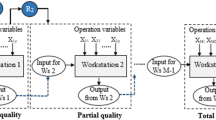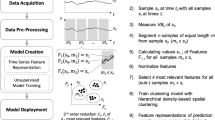Abstract
Increasing market demand towards higher product and process quality and efficiency forces companies to think of new and innovative ways to optimize their production. In the area of high-tech manufacturing products, even slight variations of the product state during production can lead to costly and time-consuming rework or even scrapage. Describing an individual product’s state along the entire manufacturing programme, including all relevant information involved for utilization, e.g., in-process adjustments of process parameters, can be one way to meet the quality requirements and stay competitive. Ideally, the gathered information can be directly analyzed and in case of an identified critical trend or event, adequate action, such as an alarm, can be triggered. Traditional methods based on modelling of cause-effect relations reaches its limits due to the fast increasing complexity and high-dimensionality of modern manufacturing programmes. There is a need for new approaches that are able to cope with this complexity and high-dimensionality which, at the same time, are able to generate applicable results with reasonable effort. Within this paper, the possibility to generate such a system by applying a combination of Cluster Analysis and Supervised Machine Learning on product state data along the manufacturing programme will be presented. After elaborating on the different key aspects of the approach, the applicability on the identified problem in industrial environment will be discussed briefly.












Similar content being viewed by others
References
Albino, V., Pontrandolfo, P., & Scozzi, B. (2002). Analysis of information flows to enhance the coordination of production processes. International Journal of Production Economics, 75, 7–19.
Apley, D., & Shi, J. (2001). A factor-analysis method for diagnosing variability in mulitvariate manufacturing processes. Technometrics, 43(1), 84–95.
Babiceanu, R., & Chen, F. (2006). Development and applications of holonic manufacturing systems: A survey. Journal of Intelligent Manufacturing, 17(1), 111–131.
Borror, C., Montgomery, D., & Runger, G. (1999). Robustness of the EWMA control chart to non-normality. Journal of Quality Technology, 31(3), 309–316.
Boon-itt, S. (2010). An empirical model of the relationship between manufacturing capabilities: Evidence from the Thai automotive industry. NIDA Development Journal, 59(2), 19–45.
Brinksmeier, E. (1991). Prozeß- und Werkstückqualität in der Feinbearbeitung. Fortschritt-Berichte VDI Reihe2: Fertigungstechnik Nr. 234. Düsseldorf: VDI Verlag.
Chinnam, R. B. (2002). Support vector machines for recognizing shifts in correlated and other manufacturing processes. International Journal of Production Research, 40(17), 4449–4466.
Chou, Y., Polansky, A., & Mason, R. (1998). Transforming non-normal data to normality in statistical process control. Journal of Quality Technology, 30(2), 133–141.
Choudhary, A. K., Harding, J. A., & Tiwari, M. K. (2009). Data mining in manufacturing: A review based on the kind of knowledge. Journal of Intelligent Manufacturing, 20(5), 501–521.
Clausen, B., Frerichs, F., Goch, G., Klein, D., Lübben, Th, Nowag, L., et al. (2006). Verzugsentstehung von Wälzlagerringen—Eine prozesskettenübergreifende Analyse. HTM Z. Werkst. Wärmebeh. Fertigung, 6(61), 309–319.
de Groot, P. J., Postma, G. J., Melssen, W. J., & Buydens, L. M. C. (1999). Selecting a representative training set for the classification of demolition waste using remote NIR sensing. Analytica Chimica Acta, 392(1999), 67–75.
Ding, Y., Ceglarek, D., & Shi, J. (2002). Fault diagnosis of multistage manufacturing processes by using state space approach. Journal of Manufacturing Science and Engineering, 124(2), 313–322. doi:10.1115/1.1445155.
Du, R., Elbestawi, M. A., & Wu, S. M. (1995). Automated monitoring of manufacturing processes, part 1: Monitoring methods. Journal of Engineering for Industry, 117(2), 121–132.
Fischer, D., & Breitenbach, J. (Eds.). (2009). Die Pharmaindustrie: Einblick, Durchblick, Perspektiven. Heidelberg: Spektrum Akademischer Verlag.
Giebel, M., Essmann, H., Du Preez, N., & Jochem, R. (2009). Improved innovation through the integration of quality gates into the enterprise and product lifecycle roadmaps. CIRP Journal of Manufacturing Science and Technology, 1(3), 199–205.
Gogouvitis, S., Konstanteli, K., Waldschmidt, S., Kousiouris, G., Katsaros, G., Menychtas, A., et al. (2012). Workflow management for soft real-time interactive applications in virtualized environments. Future Generation Computer Systems, 28(1), 193–209.
Hamel, L. (2009). Knowledge discovery with support vector machines. Hoboken: Wiley, ISBN 978-0-470-37192-3.
Hicks, B. J., Culley, S. J., & McMohan, C. A. (2006). A study of issues relating to information management across engineering SMEs. International Journal of Information Management, 26, 267–289.
Holcomb, M. C. (1994). Customer service measurement: A methodology for increasing customer value through utilization of the Taguchi strategy. Journal of Business Logistics, 15(1), 29–52.
Jacob, J., & Petrick, K. (2007). Qualitätsmanagement und Normung. In R. Schmitt & T. Pfeifer (Eds.), Masing Handbuch Qualitätsmanagement (pp. 101–121). München: Carl Hanser Verlag.
Jansen-Vullers, M. H., van Drop, C. A., & Beulens, A. J. M. (2003). Managing traceability information in manufacture. International Journal of Information Management, 23, 395–413.
Jenab, K., & Ahi, P. (2010). Fuzzy quality feature monitoring model. International Journal of Production Research, 48(17), 5021–5030.
Jiang, P., Jia, F., Wang, Y., & Zheng, M. (2012). Real-time quality monitoring and predicting model based on error propagation networks for multistage machining processes. Journal of Intelligent Manufacturing (online first-2012).
Kalpakjian, S., & Schmid, S. R. (2009). Manufacturing engineering and technology. New Jersey: Prentice Hall.
Kessler, O., Prinz, Ch., Sackmann, T., Nowag, L., Surm, H., Frerichs, F., et al. (2006). Experimental study of distortion phenomena in manufacturing lines. Materialwissenschaft und Werkstofftechnik, 37(1), 11–18.
Koufteros, X. A., Vonderembse, M. A., & Doll, W. J. (2002). Examine the competitive capabilities of manufacturing firms. Structural Equation Modelling, 9(2), 256–282.
Kovacic, M., & Sarler, B. (2009). Application of the genetic programming for increasing the soft annealing productivity in steel industry. Materials and Manufacturing Processes, 24, 369–374.
Manning, C. D., Raghavan, P., & Schütze, H. (2009). An introduction to information retrieval. Cambridge, UK: Cambridge University Press.
Megahed, F. M., & Camelio, J. A. (2010). Real-time fault detection in manufacturing environments using face recognition techniques. Journal of Intelligent Manufacturing, 23(3), 393–408.
Merali, Y., & Bennet, Z. (2011). Web 2.0 and Network Intelligence. In P. Warren, J. Davies, & E. Simperl (Eds.), Context and semantics for knowledge management (pp. 11–26). Heidelberg: Springer.
Mizuyama, H. (2004). Directing quality improvement efforts in a multi-stage production process through observational data analysis. In Proceedings of the 8th international conference on manufacturing and management, pp. 414–421.
Mizuyama, H. (2006). it Artificial-neural-network-based MSQIM for exploratory analysis of manufacturing data. In Proceedings of the 7th Asia-Pacific industrial engineering and management systems conference.
Mohanty, P. P. (2004). An agent-oriented approach to resolve the production planning complexities for a modern steel manufacturing system. International Journal of Advanced Manufacturing Technology, 24, 199–205.
Monostori, L., Váncza, J., & Kumara, S. R. T. (2006). Agent-based systems for manufacturing. CIRP Annals-Manufacturing Technology, 55(2), 697–720.
Pavletic, D., & Sokovic, M. (2009). Quality improvement model at the manufacturing process preparation level. International Journal of Quality Research, 3(4), 309–315.
Robinson, C. J., & Malhotra, M. K. (2005). Defining the concept of supply chain quality management and its relevance to academic and industrial practice. International Journal of Production Economics, 96(3), 315–337.
Scheidat, T., Leich, M., Alexander, M., & Vielhauer, C. (2009). Support vector machines for dynamic biometric handwriting classification. In Proceedings of AIAI Workshops, pp. 118–125.
Seifert, M. (2009). Collaboration formation in virtual organisations by applying prospective performance measurement. Bremer Schriften zur Integrierten Produkt- und Prozessentwicklung: Dissertation at the University of Bremen.
Sha, L., Abdelzaher, T., Arzen, K.-E., Cervin, A., Baker, T., Burns, A., et al. (2004). Real-time scheduling theory: A historical perspective. Real-Time Systems, 28(2–3), 101–155.
Shukla, C. S., & Frank Chen, F. (1996). The state of the art in intelligent real-time FMS control: A comprehensive survey. Journal of Intelligent Manufacturing, 7(6), 441–455.
Silva, R. G. (2009). Condition monitoring of the cutting process using a self-organizing spiking neural network map. Journal of Intelligent Manufacturing, 21(6), 823–829.
Siyasiya, C., van Rooyen, G. T., & Stumpf, W. E. (2005). Metallurgical factors that affect the strand width during continuous casting of DIN 1.4003 stainless steel. The Journal of The South African Institute of Mining and Metallurgy, 105, 473–481.
Spath, D., Scharer, M., Landwehr, R., Förster, H., & Schneider, W. (2001). Tore öffnen—Quality-Gate-Konzept für den Produktentstehungsprozess. QZ Qualität und Zuverlässigkeit, 46(12), 1544–1549.
Stoumbos, Z., & Sullivan, J. (2002). Robustness to non-normality of the multivariate EWMA control chart. Journal of Quality Technology, 34(3), 260–276.
Sukchotrat, T., Kim, S. B., & Tsung, F. (2009). One-class classification-based control charts for multivariate process monitoring. IIE Transactions, 42(2), 107–120.
Vapnik, V. (1998). Statistical learning theory. Hoboken: Wiley.
Wang, K., & Tsung, F. (2007). Run-to-run process adjustment using categorical observations. Journal of Quality Technology, 39(4), 312–325.
Wuest, T., Irgens, C. & Thoben, K.-D. (2012). Analysis of manufacturing process sequences, using machine learning on intermediate product states (as process proxy data). In C. Emmanouilidis, M. Taisch, & D. Kiritsis (Eds.), Competitive manufacturing for innovative products and services. In Proceedings of the APMS 2012 international conference of advances in production management systems, September 24–26, 2012, Rhodes Island, Greece. (to be published by Springer).
Wuest, T., Klein, D., & Thoben, K.-D. (2011). State of steel products in industrial production processes. Procedia Engineering, 10, 2220–2225.
Yu, T. & Wang, G. (2009). The process quality control of single-piece and small-batch products in advanced manufacturing environment. In Proceedings of the 16th international conference on industrial engineering and engineering management. (IE &EM ’09), October 21–23, 2009, Beijing, China, pp. 306–310.
Zantek, P. F., Wright, G. P., & Plante, R. D. (2006). A self-starting procedure for monitoring process quality in multistage manufacturing systems. IIE Transactions, 38(4), 293–308.
Zhang, J., & Wang, H. (2009). A minimized zero mean entropy approach to networked control systems. In Proceedings of the 48th IEEE Conference on Decision and Control (CDC) held jointly with 2009 28th Chinese Control Conference (pp. 6876–6881). Shanghai, China: IEEE. doi:10.1109/CDC.2009.5400679.
Zoch, H.-W. & Lübben, Th. (2011). Verzugsbeherrschung—Systemorientierter Ansatz als wesentliche Voraussetzung für den Erfolg. Tagungsband zum 26. Aachener Stahlkolloquium, Verlagshaus Mainz.
Zoch, H.-W. (2012). Distortion engineering-interim results after one decade research within the Collaborative Research Center. Materialwissenschaft und Werkstofftechnik, 43(1–2), 9–15.
Acknowledgments
The authors would like to thank the “Deutsche Forschungsgemeinschaft” for financial support via the funded project “Informationssystem für werkstoffwissenschaftliche Forschungsdaten”.
Author information
Authors and Affiliations
Corresponding author
Rights and permissions
About this article
Cite this article
Wuest, T., Irgens, C. & Thoben, KD. An approach to monitoring quality in manufacturing using supervised machine learning on product state data. J Intell Manuf 25, 1167–1180 (2014). https://doi.org/10.1007/s10845-013-0761-y
Received:
Accepted:
Published:
Issue Date:
DOI: https://doi.org/10.1007/s10845-013-0761-y




